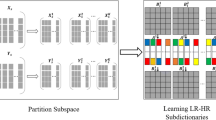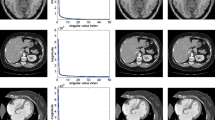Abstract
Chinese Government has launched ambitious healthcare reform aiming to provide better healthcare services for both urban and rural residents via remote diagnosis. Recently, the requirement of high-resolution (HR) images becomes more urgent in the medical field, especially for remote diagnosis. Remote diagnosis is an important means of the Internet of Medical Things (IoMT), which senses patients’ health status according to the medical images and transfers clinical data. Owing to the superiority of reconstruction speed and quality, adjusted anchored neighborhood regression has attracted much attention. However, the hypercells formed by neighborhoods may not center on atoms, and hence it is not accurate to group the neighborhood centered on atoms. In this paper, we propose an adaptive medical image enhancement method. Specifically, we cluster training samples into neighborhoods centered on patches. The LR space is re-divided by replacing dictionary atoms with cluster patch centers as the center of hypercells. By this means, the neighborhood anchored in the patch is defined by computing its K nearest patches, and then applied to pre-compute the projection to map low-resolution patch onto the HR domain. Average quantitative results show that our method is superior to the compared methods in two common medical datasets by 1.19% and 2.32%, respectively, while maintaining the similar running time.






Similar content being viewed by others
References
Bevilacqua M, Roumy A, Guillemot C, Alberi-Morel M (2012) Low-complexity single-image super-resolution based on nonnegative neighbor embedding. In: British machine vision conference, BMVC 2012. Surrey, UK, September, 3-7 2012, pp 1-10
Cao F, Cai M, Tan Y (2015) Image interpolation via low-rank matrix completion and recovery. IEEE Trans Circuits Syst Video Techn 25(8):1261–1270
Chang H, Yeung D, Xiong Y (2004) Super-resolution through neighbor embedding. In: 2004 IEEE computer society conference on computer vision and pattern recognition (CVPR 2004), with CD-ROM, 27 June - 2 July 2004. Washington, DC, pp 275–282
Chianese A, Marulli F, Piccialli F (2016) Cultural heritage and social pulse: a semantic approach for CH sensitivity discovery in social media data. In: Tenth IEEE International conference on semantic computing, ICSC 2016, Laguna Hills, CA, USA, February 4–6, 2016, pp 459–464
Dong W, Zhang L, Shi G, Wu X (2011) Image deblurring and super-resolution by adaptive sparse domain selection and adaptive regularization. IEEE Trans Image Processing 20(7):1838–1857
Dong W, Zhang L, Shi G, Li X (2013) Nonlocally centralized sparse representation for image restoration. IEEE Trans Image Processing 22(4):1620–1630
Dou Q, Wei S, Yang X, Wu W, Liu K (2018) Medical image super-resolution via minimum error regression model selection using random forest. Sustain Cities Soc 42:1–12
Duanmu C, Zhao D, Jiang D, Song H, Xiong J (2016) A three dimension super-resolution algorithm through neighbor embedding based on weighted coefficient values for internet of things. In: International Conference on identification, information and knowledge in the internet of things, IIKI 2016, Beijing, China, October 20–21, 2016, pp 150–155
Early DS, Long DG (2001) Image reconstruction and enhanced resolution imaging from irregular samples. IEEE Trans Geosci Remote Sens 39(2):291–302
Fernandez-Granda C, Candès EJ (2013) Super-resolution via transform-invariant group-sparse regularization. In: IEEE International conference on computer vision, ICCV 2013, Sydney, Australia, December 1–8, 2013, pp 3336–3343
Gao X, Zhang K, Tao D, Li X (2012) Image super-resolution with sparse neighbor embedding. IEEE Trans Image Process 21(7):3194–3205
Greenspan H (2009) Super-resolution in medical imaging. Comput J 52(1):43–63
Huang J, Siu W, Liu T (2015) Fast image interpolation via random forests. IEEE Trans Image Process 24(10):3232–3245
Huang K, Hu R, Jiang J, Han Z, Wang F (2016) Face image super-resolution through improved neighbor embedding. In: MultiMedia modeling - 22nd international conference, MMM 2016, Miami, FL, USA, January 4-6, 2016. Proceedings, Part I, pp 409–420
Hussain S, Keung J, Khan AA, Ahmad A, Cuomo S, Piccialli F, Jeon G, Akhunzada A (2018) Implications of deep learning for the automation of design patterns organization. J Parallel Distrib Comput 117:256–266
Jiang J, Chen C, Ma J, Wang Z, Wang Z, Hu R (2017) SRLSP: a face image super-resolution algorithm using smooth regression with local structure prior. IEEE Trans Multimed 19(1):27–40
Jiang J, Ma X, Chen C, Lu T, Wang Z, Ma J (2017) Single image super-resolution via locally regularized anchored neighborhood regression and nonlocal means. IEEE Trans Multimed 19(1):15–26
Marquina A, Osher S (2008) Image super-resolution by tv-regularization and Bregman iteration. J Sci Comput 37(3):367–382
Park JS, Soh JW, Cho NI (2018) High dynamic range and super-resolution imaging from a single image. IEEE Access 6:10,966–10,978
Romano Y, Protter M, Elad M (2014) Single image interpolation via adaptive nonlocal sparsity-based modeling. IEEE Trans Image Process 23(7):3085–3098
Sun J, Xu Z, Shum H (2008) Image super-resolution using gradient profile prior. In: 2008 IEEE Computer society conference on computer vision and pattern recognition (CVPR 2008), 24-26 June, 2008. Anchorage, Alaska, USA
Timofte R, Smet VD, Gool LJV (2013) Anchored neighborhood regression for fast example-based super-resolution. In: IEEE International conference on computer vision, ICCV 2013, Sydney, Australia, December 1-8, 2013, pp 1920–1927
Timofte R, Smet VD, Gool LJV (2014) A+: adjusted anchored neighborhood regression for fast super-resolution. In: Computer Vision - ACCV 2014 - 12th Asian conference on computer vision, Singapore, Singapore, November 1-5, 2014. Revised Selected Papers, Part IV, pp 111–126
Timofte R, Rothe R, Gool LV (2016) Seven ways to improve example-based single image super resolution. In: 2016 IEEE Conference on computer vision and pattern recognition, CVPR 2016, Las Vegas, NV, USA, June 27-30, 2016, pp 1865–1873
Wang L, Xiang S, Meng G, Wu H, Pan C (2013) Edge-directed single-image super-resolution via adaptive gradient magnitude self-interpolation. IEEE Trans Circuits Syst Video Techn 23(8):1289–1299
Wang Z, Yang Y, Wang Z, Chang S, Han W, Yang J, Huang TS (2015) Self-tuned deep super resolution. In: 2015 IEEE Conference on computer vision and pattern recognition workshops, CVPR Workshops. Boston, MA, USA, June 7-12, 2015, pp 1–8
Wei Z, Ma K (2013) Contrast-guided image interpolation. IEEE Trans Image Process 22(11):4271–4285
Wu L, Wang Y (2010) The process of criminal investigation based on grey hazy set. In: Proceedings of the IEEE international conference on systems, man and cybernetics, Istanbul, Turkey, 10-13 October 2010, pp 26-28
Wu H, Zhang J, Wei Z (2018) High resolution similarity directed adjusted anchored neighborhood regression for single image super-resolution. IEEE Access 6:25,240–25,247
Yang J, Wright J, Huang TS, Ma Y (2010) Image super-resolution via sparse representation. IEEE Trans Image Process 19(11):2861–2873
Yang W, Liu J, Li M, Guo Z (2018) Isophote-constrained autoregressive model with adaptive window extension for image interpolation. IEEE Trans Circuits Syst Video Techn 28(5):1071–1086
Ye W, Ma K (2016) Convolutional edge diffusion for fast contrast-guided image interpolation. IEEE Signal Process Lett 23(9):1260–1264
Zeyde R, Elad M, Protter M (2010) On single image scale-up using sparse-representations. In: Curves and Surfaces - 7th international conference, Avignon, France, June 24-30, 2010, Revised Selected Papers, pp 711–730
Zhang K, Tao D, Gao X, Li X, Xiong Z (2015) Learning multiple linear mappings for efficient single image super-resolution. IEEE Trans Image Process 24(3):846–861
Zhang K, Wang B, Zuo W, Zhang H, Zhang L (2016) Joint learning of multiple regressors for single image super-resolution. IEEE Signal Process Lett 23 (1):102–106
Zhao J, Sun T, Cao F (2018) Image super-resolution via adaptive sparse representation and self-learning. IET Comput Vis 12(5):753–761
Zhu S, Zeng B, Zeng L, Gabbouj M (2016) Image interpolation based on non-local geometric similarities and directional gradients. IEEE Trans Multimed 18 (9):1707–1719
Acknowledgments
This work is sponsored by Key Research and Development Project of Science and Technology Commission Foundation of Sichuan Province (2018FZ0036) and the National Natural Science 506 Foundation of China (grant no. 61711540303 and 61701327).
Author information
Authors and Affiliations
Corresponding authors
Additional information
Publisher’s note
Springer Nature remains neutral with regard to jurisdictional claims in published maps and institutional affiliations.
Rights and permissions
About this article
Cite this article
Jiang, L., Ye, S., Yang, X. et al. An adaptive anchored neighborhood regression method for medical image enhancement. Multimed Tools Appl 79, 10533–10550 (2020). https://doi.org/10.1007/s11042-019-08353-y
Received:
Revised:
Accepted:
Published:
Issue Date:
DOI: https://doi.org/10.1007/s11042-019-08353-y




